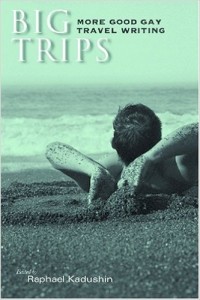 Big Trips: More Good Gay Travel Writing
Big Trips: More Good Gay Travel Writing
Edited by Raphael Kadushin
University of Wisconsin Press
308 pages, $24.95
IN HIS INTRODUCTION to Big Trips, Raphael Kadushin—a senior editor for the book’s publisher, the University of Wisconsin Press—affirms his hope that the sixteen entries in this anthology will address two unfortunate tendencies in today’s travel writing. First, he laments the brevity and shallowness of most travel accounts, especially those appearing on the Internet. Second, he criticizes the abandonment of universal themes in classic travel pieces in favor of self-indulgent memoirs. On both counts, this collection succeeds, providing a refreshing alternative to the hollow sound bites that have supplanted more traditional travel narratives.
Big Trips assembles an impressive group of writers, including both well-established authors and emerging voices, who visit a culturally expansive range of places. Thus are we transported from a mesmeric Cairo to an Americanized Prague, from a gai Paris to a sultry Corfu, from the bathhouses of Vienna to the deserts in Morocco, or from 1970’s Rome to contemporary San Francisco. The book is divided into two large sections: the ten pieces in “Going Out” explore the euphoria of travel by narrators who set out to reinvent themselves through an adventure; the six pieces in “Coming Back” have a more introspective tone, highlighting a journey back to a place once visited. For all the stories’ uniqueness, several universal themes do emerge, among them sex, love, nostalgia, and death.
Travel opens up opportunities for sexual encounters. In the opening story, Aaron Hamburger’s “Lukas’ Story,” the narrator decides to move to Prague to teach English after discovering a pornographic video featuring Czech boys titled Lucas’ Story. Once in Prague, he has an affair with a man named Lukás and learns that the once communist city has already been invaded by American chain stores. In Douglas A. Martin’s “The Heart of Paris,” a stranded traveler at a station in Paris waits for his train to London. Bored and broke, the marooned narrator walks outside, only to be followed by a man with whom he ends up spending the night, barely exchanging any words—a fleeting encounter in “the city of lights.”
Love is in the Parisian air in Edmund White’s “Skinned Alive,” in which an American writer living in Paris details his love affair with an arriviste named Jean-Loup, a young man from Bordeaux. When Jean-Loup begs White to write a description of his ass “as Francis Ponge describes soap: an objective, exhaustive, whimsical catalog of its properties,” the author obliges with a hilarious homage to Jean-Loup’s rear end. Once their affair comes to an end, the narrator falls in love with another young man, an American from Georgia named Paul who works as a physiognomist, “the person who recognizes the regulars and celebrities” at the door of a trendy club. They travel to southern Morocco and visit the desert, where the narrator observes: “It occurred to me that if I thought only now, at this moment in my life, of belonging to someone else, it was because my hold on life itself was endangered.” At one point an interviewer asks White, “You are known as a homosexual, a writer, and an American. When did you first realize you were an American?” and the author gets the last laugh: “When I moved to France.” Clifford Chase’s “Egypt, in One Sense” explores the unraveling of love through a unique, lyrical oscillation between fragmentation and coherence, echoing the overarching theme of the story.
All travel writing is in some sense tinged with nostalgia. Ty Geltmaker’s “Lamb of God,” for example, is set in the Rome of the 1970’s, by today’s standards an unrecognizable city plagued by the remnants of fascist thought. Bruce Benderson’s “Return to San Francisco” also flashes back to the 70’s, but this time to a bohemian center where “famous rebels, dropouts, and cultists of the American postwar period” found a haven, and where “fugitives from the law, renegade psychologists and Satanists” made a home. In the end, Benderson concludes that the rebellious culture of San Francisco lost its vitality in the 90’s, corrupted by American mainstream values: “Counterculture types from my era have moved away, died, or ‘reformed.’ Liberal as the city is, San Francisco is now completely infused with a work ethic, making it little different than the rest of America.”
Death as a literary theme also haunts these disparate pieces. One of the most daring stories is Mark Friedman’s “Fugitive Emissions,” which recounts the road trip of a pedophile with the ashes of his dead mother as he returns to a hostel on the Pacific Coast of Mexico, where he had almost drowned in the pool as a young boy. On a very different note, Trebor Healy’s “Saint Andy,” a chapter from a novel in progress, poignantly tells the story of Seamus, who bikes across America with the ashes of Jimmy, his dead lover. Philip Gambone’s “To the Miraculous Land of Beauty” celebrates the music of Schubert as the narrator makes a pilgrimage to the composer’s tombstone in Vienna’s Zentralfriedhof.
The generally high literary tenor of this collection is maintained in other pieces too numerous to describe, including “Taormina,” by Duncan Fallowell, “A Wedding in the Sky,” by Michael Klein, “The Law of Diminishing Returns,” by Dale Peck, and “On Going Back,” by Brian Bouldrey. It should be noted that Kadushin produced a collection of gay travel writing in 2004 called Wonderlands: Good Gay Travel Writing, which features some of the same authors. Like the young Marcel Proust’s magic lantern projecting legends on shifting windows, these stories allow the reader to travel vicariously to distant places while enjoying the art of travel writing at its best. Bon voyage!





